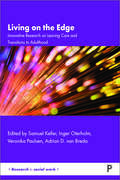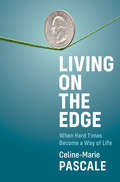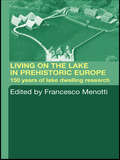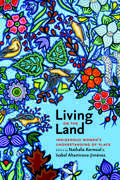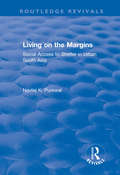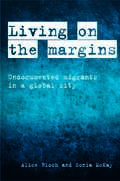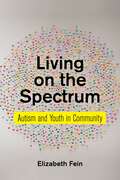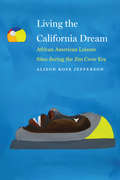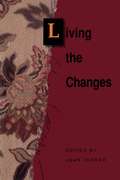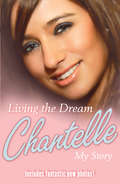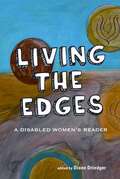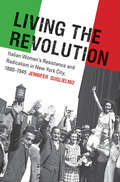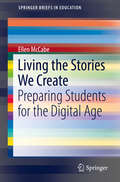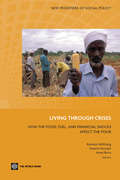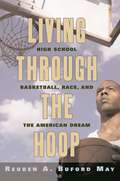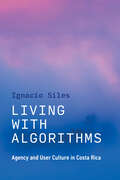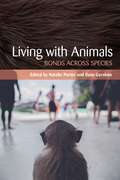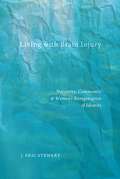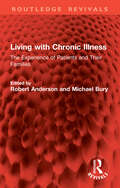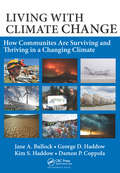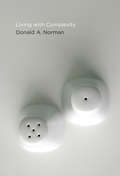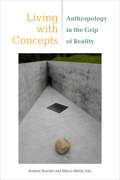- Table View
- List View
Living on the Edge: Innovative Research on Leaving Care and Transitions to Adulthood
by Samuel Keller, Inger Oterholm, Veronika Paulsen and Adrian D. van BredaEPDF and EPUB available Open Access under CC-BY licence. Young people transitioning out of care towards independence, work and adulthood are on the edge of these phases of life. Considering previously neglected groups of care leavers such as unaccompanied migrants, street youth, those leaving residential care, young parents and those with a disability, this book presents cutting-edge research from emerging global scholars. The collection addresses the precarity experienced by many care leavers, who often lack the social capital and resources to transition into stable education, employment and family life. Including the voices of care leavers throughout, it makes research relevant to practitioners and policymakers aiming to enable, rather than label, vulnerable groups.
Living on the Edge: When Hard Times Become a Way of Life
by Celine-Marie PascaleFor the majority of Americans, hard times have long been a way of life. Some work multiple low-wage jobs, others face the squeeze of stagnant wages and rising costs of living. Sociologist Celine-Marie Pascale talked with people across Appalachia, at the Standing Rock and Wind River reservations, and in the bustling city of Oakland, California. Their voices offer a wide range of experiences that complicate dominant national narratives about economic struggles. Yet Living on the Edge is about more than individual experiences. It’s about a nation in a deep economic and moral crisis. It’s about the long-standing collusion between government and corporations that prioritizes profits over people, over the environment, and over the nation’s well-being. It’s about how racism, sexism, violence, and the pandemic shape daily experience in struggling communities. And, ultimately, it’s a book about hope that lays out a vision for the future as honest as it is ambitious. Most people in the book are not progressives; none are radicals. They’re hard-working people who know from experience that the current system is unsustainable. Across the country people described the need for a living wage, accessible health care, immigration reform, and free education. Their voices are worth listening to.
Living on the Lake in Prehistoric Europe: 150 Years of Lake-Dwelling Research
by Francesco MenottiThe chance discovery in 1854 of a prehistoric lake village on Lake Zurich triggered what we now call the 'lake-dwelling phenomenon'. One hundred and fifty years of research and animated academic disputes have transformed the phenomenon into one of the most reliable sources of information in wetland archaeology.This definitive volume provides an overview of the development of lake village studies, explores the impact of a range of scientific techniques on the settlements and considers how the public can relate to this evocative and exciting branch of archaeology. It explains how the multidisciplinary research context has significantly improved our knowledge of prehistoric wetland communities, from an environmental as well as a cultural perspective.
Living on the Land: Indigenous Women's Understanding of Place
by Isabel Altamirano-Jiménez Nathalie KermoalAn extensive body of literature on Indigenous knowledge and ways of knowing has been written since the 1980s. This research has for the most part been conducted by scholars operating within Western epistemological frameworks that tend not only to deny the subjectivity of knowledge but also to privilege masculine authority. As a result, the information gathered predominantly reflects the types of knowledge traditionally held by men, yielding a perspective that is at once gendered and incomplete. Even those academics, communities, and governments interested in consulting with Indigenous peoples for the purposes of planning, monitoring, and managing land use have largely ignored the knowledge traditionally produced, preserved, and transmitted by Indigenous women. While this omission reflects patriarchal assumptions, it may also be the result of the reductionist tendencies of researchers, who have attempted to organize Indigenous knowledge so as to align it with Western scientific categories, and of policy makers, who have sought to deploy such knowledge in the service of external priorities. Such efforts to apply Indigenous knowledge have had the effect of abstracting this knowledge from place as well as from the world view and community—and by extension the gender—to which it is inextricably connected. Living on the Land examines how patriarchy, gender, and colonialism have shaped the experiences of Indigenous women as both knowers and producers of knowledge. From a variety of methodological perspectives, contributors to the volume explore the nature and scope of Indigenous women’s knowledge, its rootedness in relationships both human and spiritual, and its inseparability from land and landscape. From the reconstruction of cultural and ecological heritage by Naskapi women in Québec to the medical expertise of Métis women in western Canada to the mapping and securing of land rights in Nicaragua, Living on the Land focuses on the integral role of women as stewards of the land and governors of the community. Together, these contributions point to a distinctive set of challenges and possibilities for Indigenous women and their communities.
Living on the Margins: Social Access To Shelter In Urban South Asia (Soas Studies In Development Geography)
by Navtej K. PurewalThis title was first published in 2000. The privatization of former social state housing through recent public-private partnerships is becoming increasingly prevalent in Third World as well as in Western countries. In most Third World countries, this shift has had profound effects upon the patterns of access of shelter. Drawing on studies of South Asian and other Third World contexts, as well as original in-depth empirical research from Amritsar, a city in North-West India, this book offers an analysis of the withdrawal of state housing provision. It develops and applies a unique model based on social status to analyze the new routes of access to housing and land by the urban poor. Its conclusions argue that these new privatization policies largely rely upon already existing informal and self-help settlements which continue to attract the poor and to be the largest housing providers in many cities, thus providing a ready-made safety net for such policies. The inter-linkages between the private state and the public market make up a highly diversified and complex picture of shelter arrangements being accessed by the poor which is reflected in the social differentiation and increasingly stratified housing market. The book argues that these partnership policies therefore have long-term implications upon social patterns of inclusion and exclusion which must be addressed.
Living on the Margins: Social Access to Shelter in Urban South Asia (Routledge Revivals)
by Navtej K. PurewalThis title was first published in 2000. The privatization of former social state housing through recent public-private partnerships is becoming increasingly prevalent in Third World as well as in Western countries. In most Third World countries, this shift has had profound effects upon the patterns of access of shelter. Drawing on studies of South Asian and other Third World contexts, as well as original in-depth empirical research from Amritsar, a city in North-West India, this book offers an analysis of the withdrawal of state housing provision. It develops and applies a unique model based on social status to analyze the new routes of access to housing and land by the urban poor. Its conclusions argue that these new privatization policies largely rely upon already existing informal and self-help settlements which continue to attract the poor and to be the largest housing providers in many cities, thus providing a ready-made safety net for such policies. The inter-linkages between the private state and the public market make up a highly diversified and complex picture of shelter arrangements being accessed by the poor which is reflected in the social differentiation and increasingly stratified housing market. The book argues that these partnership policies therefore have long-term implications upon social patterns of inclusion and exclusion which must be addressed.
Living on the Margins: Undocumented Migrants in a Global City
by Alice Bloch Sonia McKayLiving on the margins offers a unique insight into the working lives of undocumented (or ‘irregular’) migrants living in London, and their employers. Breaking new ground, this topical book exposes the contradictions in policies, which marginalise and criminalise these migrants, while promoting exploitative labour market policies. However, the book reveals that the migrants can be active agents in shaping their lives within the constraint of status. Taking an inter-disciplinary approach, this fascinating book offers an international context to the research and provides theoretical, policy and empirical analyses. It will appeal to undergraduate and postgraduate students, researchers and academics, as well as policy makers, practitioners and interested non-specialists.
Living on the Spectrum: Autism and Youth in Community (Anthropologies of American Medicine: Culture, Power, and Practice #8)
by Elizabeth FeinHonorable Mention, 2020 Stirling Prize for Best Published Work in Psychological Anthropology, given by the Society for Psychological AnthropologyHonorable Mention, New Millennium Book Award, given by the Society for Medical AnthropologyHow youth on the autism spectrum negotiate the contested meanings of neurodiversityAutism is a deeply contested condition. To some, it is a devastating invader, harming children and isolating them. To others, it is an asset and a distinctive aspect of an individual’s identity. How do young people on the spectrum make sense of this conflict, in the context of their own developing identity? While most of the research on Asperger’s and related autism conditions has been conducted with individuals or in settings in which people on the spectrum are in the minority, this book draws on two years of ethnographic work in communities that bring people with Asperger’s and related conditions together. It can thus begin to explore a form of autistic culture, through attending to how those on the spectrum make sense of their conditions through shared social practices.Elizabeth Fein brings her many years of experience in both clinical psychology and psychological anthropology to analyze the connection between neuropsychological difference and culture. She argues that current medical models, which espouse a limited definition, are ill equipped to deal with the challenges of discussing autism-related conditions. Consequently, youths on the autism spectrum reach beyond medicine for their stories of difference and disorder, drawing instead on shared mythologies from popular culture and speculative fiction to conceptualize their experience of changing personhood. In moving and persuasive prose, Living on the Spectrum illustrates that young people use these stories to pioneer more inclusive understandings of what makes us who we are.
Living the California Dream: African American Leisure Sites during the Jim Crow Era
by Alison Rose JeffersonAs Southern California was reimagining leisure and positioning it at the center of the American Dream, African American Californians were working to make that leisure an open, inclusive reality. By occupying recreational sites and public spaces, African Americans challenged racial hierarchies and marked a space of black identity on the regional landscape and social space. In Living the California Dream Alison Rose Jefferson examines how African Americans pioneered America&’s &“frontier of leisure&” by creating communities and business projects in conjunction with their growing population in Southern California during the nation&’s Jim Crow era. By presenting stories of Southern California African American oceanfront and inland leisure destinations that flourished from 1910 to the 1960s, Jefferson illustrates how these places helped create leisure production, purposes, and societal encounters. Black communal practices and economic development around leisure helped define the practice and meaning of leisure for the region and the nation, confronted the emergent power politics of recreational space, and set the stage for the sites as places for remembrance of invention and public contest. Living the California Dream presents the overlooked local stories that are foundational to the national narrative of mass movement to open recreational accommodations to all Americans and to the long freedom rights struggle.
Living the Changes
by Joan TurnerLiving the Changes explores the nature and extent of women's changing realities. The contributors include writers, artists, academics, street kids and social workers, and range in age from nine to seventy-three. Their topics reflect the diversity and complexity of the concerns of contemporary women – birthing and aging, body image, culture, drugs, violence, sexual abuse, prostitution, reproductive technology, and spirituality.
Living the Dream: My Story
by Chantelle HoughtonFrom girl next door to the nation's sweetheart, this is the story of Chantelle's spectacular rise to fame and celebrity. Told in her own words, Chantelle takes us on what has been a sometimes bumpy, but a truly magical journey.As a little girl growing up in Essex, Chantelle Houghton dreamed of becoming famous and living the life of a star. But never could she have imagined just how this dream would eventually come true, transforming her into one of Britain's most loved and talked about celebrities.Here, we learn how her family played a crucial role in helping to shape her dreams and aspirations from an early age. We hear of the difficult times growing up and how Chantelle was able to overcome these obstacles, eventually launching a career in modeling.But it was to be Celebrity Big Brother that would change the course of Chantelle's life forever. She tells of the moment she first discovered she'd been picked, what really went on behind the scenes - the clashes of personalities in the house, the fallings out... and, of course, her falling in love with Preston.Winning Big Brother was a defining moment, and the madness that followed in those first few days outside of the house was to be just the beginning of Chantelle's new dream life. Learning to become accustomed to her new found fame hasn't been straightforward, but Chantelle has always kept her feet firmly on the ground. But it has been her love for Preston that has been the real fairy tale in Chantelle's extraordinary journey. She tells how their love grew away from the glare of paparazzi, and how this whirlwind romance ended up becoming the wedding of the year. In this honest and open autobiography, Chantelle shares her secret hopes and dreams for the future and looks back on the past year and reflects on just what an amazing fairy tale it's been.
Living the Edges: A Disabled Women's Reader (Inanna Reader Ser.)
by Diane DreidgerThis anthology was compiled as a means for Canadian women with disabilities to share experiences with other disabled women and with the public at large. The collection includes poetry, artwork, personal essays, and academic studies that focus on the marginalization of women with disabilities. Selections embrace the broadest view of disability, including women with physical, sensory, mental-health, and intellectual disabilities and women dealing with chronic illness. Sections include "Who We Are on the Edges," "Naming the Edges," "Violence on the Edges," and "With Us on the Edges."
Living the Revolution: Italian Women's Resistance and Radicalism in New York City, 1880-1945
by Jennifer GuglielmoItalians were the largest group of immigrants to the United States at the turn of the twentieth century, and hundreds of thousands led and participated in some of the period's most volatile labor strikes. Yet until now, Italian women's political activism and cultures of resistance have been largely invisible. In Living the Revolution, Jennifer Guglielmo brings to life the Italian working-class women who helped shape the vibrant, transnational, radical political culture that expanded into the emerging industrial union movement. Guglielmo imaginatively documents the activism of two generations of New York and New Jersey women who worked in the needle and textile trades. She explores the complex and distinctive ways immigrant women and their American-born daughters drew on Italian traditions of protest to form new urban female networks of everyday resistance and political activism. And she shows how their commitment to revolutionary and transnational social movements diminished as they became white working-class Americans. The rise of fascism, the Red Scare, and the deprivations of the Great Depression led many to embrace nationalism and racism, ironically to try to meet the same desires for economic justice and dignity that had inspired their enthusiasm for anarchism, socialism, and communism.
Living the Stories We Create: Preparing Students for the Digital Age (SpringerBriefs in Education)
by Ellen McCabeThis work explores the potential of digital media to rectify the disparity between formal learning contexts and contemporary perceptions and expectations of narrative. How can education systems respond to the changing technological landscape, thus preparing students to become active participants in society as well as to realise the extent of their own potential? This book explores such concepts in the classroom environment through direct engagement with students and teachers with the case of Shakespeare's Macbeth. Written in approximately 1606, Macbeth has its roots in a culture of orality and yet has sustained through centuries of print dominance. Indeed, as both text and performance the work itself embodies both the literary and the oral. Yet as a staple of many second level curricula increasingly Macbeth is perceived as an educational text. Macbeth reflects its cultural moment, an age of ambiguity where much like today notions of selfhood, privacy, societal structures, media and economy were being called into question. Thus Macbeth can be understood as a microcosm of the challenges existing in contemporary education in both content and form. This book examines Macbeth as a case-study in seeking to explore the implications of digital media for learning, as well as its possible potential to constructively facilitate in realigning formal learning contexts to contemporary experiences of narrative.
Living through Crises
by Naomi Hossain Rasmus Heltberg Anna RevaWhat did the global food, fuel, and financial crises of 2008-11 mean to people living in the developing world? How did people cope with the crisis and how effective were they at averting major impacts? These are the questions addressed by this book, which emerged out of qualitative crisis monitoring initiatives carried out by IDS and the World Bank. As such, this is not a book about the causes of the crisis or how to prevent future crises. Instead, this book is about how people lived through the severe economic turmoil of recent years, how they were affected, and what they did to cope, presenting the compelling perspectives of affected communities in developing and transition countries on shocks and coping, vulnerability and resilience. The book brings together qualitative crisis monitoring conducted during 2008-2011 in communities in sixteen countries, including eight country case studies that illustrate how people in specific localities were impacted by global shocks, what coping strategies they applied, and which sources of support proved helpful. The studies in this book reveal striking similarities in people's coping responses across otherwise different countries. They also reveal widespread concern over high and volatile food prices, suggesting that the still ongoing global food crisis needs far more attention from policymakers. As the most comprehensive qualitative research on crisis impacts and coping carried out in developing countries, the book also highlights the capacity for participatory research to pick up impacts and responses that other approaches may miss and contributing to the knowledge of how to qualitatively assess shocks, vulnerability, and resilience. This book will serve as an indispensable source of reference for future crisis monitoring efforts. Written in accessible language, this book will help specialists and non-specialists alike understand how large economic crises impact people and communities and what is the role of public policy in protecting against risk.
Living through the Hoop: High School Basketball, Race, and the American Dream
by Reuben A. MayA hopeful and inspiring treatise on the power of playing basketballWhen high school basketball player LeBron James was selected as the top pick in the National Basketball Association draft of 2003, the hopes of a half-million high school basketball players soared. If LeBron could go straight from high school to the NBA, why couldn’t they? Such is the allure of basketball for so many young African American men. Unfortunately, the reality is that their chances of ever playing basketball at the professional, or even college, level are infinitesimal. In Living Through the Hoop, Reuben A. Buford May tells the absorbing story of the hopes and struggles of one high school basketball team.With a clear passion for the game, May grabs readers with both hands and pulls them onto the hardwood, going under the hoop and inside the locker room. May spent seven seasons as an assistant coach of the Northeast High School Knights in Northeast, Georgia. We meet players like Larique and Pooty Cat, hard-working and energetic young men, willing to play and practice basketball seven days a week and banking on the unlimited promise of the game. And we meet Coach Benson, their unorthodox, out-spoken, and fierce leader, who regularly coached them to winning seasons, twice going to the state tournaments Elite Eight championships.Beyond the wins and losses, May provides a portrait of the players’ hopes and aspirations, their home lives, and the difficulties they face in living in a poor and urban area—namely, the temptations of drugs and alcohol, violence in their communities, run-ins with the police, and unstable family lives. We learn what it means to become a man when you live in places that define manhood by how tough you can be, how many women you can have, and how much money you can hustle.May shows the powerful role that the basketball team can play in keeping these kids straight, away from street-life, focused on completing high school, and possibly even attending college. Their stories, and the double-edged sword of hoop dreams, is at the heart of this compelling story about young African American men’s struggle to find their way in an often grim world.Visit the author's YouTube channel!
Living with Algorithms: Agency and User Culture in Costa Rica
by Ignacio SilesA nuanced account from a user perspective of what it&’s like to live in a datafied world.We live in a media-saturated society that increasingly transforms our experiences, relations, and identities into data others can analyze and monetize. Algorithms are key to this process, surveilling our most mundane practices, and to many, their control over our lives seems absolute. In Living with Algorithms, Ignacio Siles critically challenges this view by surveying user dynamics in the global south across three algorithmic platforms—Netflix, Spotify, and TikTok—and finds, surprisingly, a more balanced relationship. Drawing on a wealth of empirical evidence that privileges the user over the corporate, Siles examines the personal relationships that have formed between users and algorithms as Latin Americans have integrated these systems into the structures of everyday life, enacted them ritually, participated in public with and through them, and thwarted them. Sometimes users follow algorithms, Siles finds, and sometimes users resist them. At times, users do both. Agency lies in the navigation of the spaces in-between. By analyzing what we do with algorithms rather than what algorithms do to us, Living with Algorithms clarifies the debate over the future of datafication and whether we have a say in its development. Concentrating on an understudied region of the global south, the book provides a new perspective on the commonalities and differences among users within a global ecology of technologies.
Living with Alzheimer's: Managing Memory Loss, Identity, and Illness
by Renée L. BeardNews of Alzheimer’s disease is constantly in the headlines. Every day we hear heart-wrenching stories of people caring for a loved one who has become a shell of their former self, of projections about rising incidence rates, and of cures that are just around the corner. However, we don't see or hear from the people who actually have the disease. In Living with Alzheimer’s, Renée L. Beard argues that the exclusively negative portrayals of Alzheimer’s are grossly inaccurate. To understand what life with memory loss is really like, Beard draws on intensive observations of nearly 100 seniors undergoing cognitive evaluation, as well as post-diagnosis interviews with individuals experiencing late-in-life forgetfulness. Since we all forget sometimes, seniors with an Alzheimer’s diagnosis ultimately need to be socialized into medicalized interpretations of their forgetfulness. In daily life, people with the disease are forced to manage stigma and the presumption of incompetence on top of the actual symptoms of their ailment. The well-meaning public, and not their dementia, becomes the major barrier to a happy life for those affected. Beard also examines how these perceptions affect treatment for Alzheimer’s. Interviews with clinicians and staff from the Alzheimer’s Association reveal that despite the best of intentions, pejorative framings of life with dementia fuel both clinical practice and advocacy efforts. These professionals perpetuate narratives about “self-loss,” “impending cures,” and the economic and emotional “burden” to families and society even if they do not personally believe them. Yet, Beard also concludes that in spite of these trends, most of the diagnosed individuals in her study achieve a graceful balance between accepting the medical label and resisting the social stigma that accompanies it. In stark contrast to the messages we receive, this book provides an unprecedented view into the ways that people with early Alzheimer’s actively and deliberately navigate their lives.
Living with Animals
by Michael PomedliWithin nineteenth-century Ojibwe/Chippewa medicine societies, and in communities at large, animals are realities and symbols that demonstrate cultural principles of North American Ojibwe nations. Living with Animals presents over 100 images from oral and written sources - including birch bark scrolls, rock art, stories, games, and dreams - in which animals appear as kindred beings, spirit powers, healers, and protectors.Michael Pomedli shows that the principles at play in these sources are not merely evidence of cultural values, but also unique standards brought to treaty signings by Ojibwe leaders. In addition, these principles are norms against which North American treaty interpretations should be reframed. The author provides an important foundation for ongoing treaty negotiations, and for what contemporary Ojibwe cultural figures corroborate as ways of leading a good, integrated life.
Living with Animals: Bonds across Species
Living with Animals is a collection of imagined animal guides—a playful and accessible look at different human-animal relationships around the world. Anthropologists and their co-authors have written accounts of how humans and animals interact in labs, in farms, in zoos, and in African forests, among other places. Modeled after the classic A World of Babies, an edited collection of imagined Dr. Spock manuals from around the world—With Animals focuses on human-animal relationships in their myriad forms.This is ethnographic fiction for those curious about how animals are used for a variety of different tasks around the world. To be sure, animal guides are not a universal genre, so Living with Animals offers an imaginative solution, doing justice to the ways details about animals are conveyed in culturally specific ways by adopting a range of voices and perspectives. How we capitalize on animals, how we live with them, and how humans attempt to control the untamable nature around them are all considered by the authors of this wild read.If you have ever experienced a moment of "what if" curiosity—what is it like to be a gorilla in a zoo, to work in a pig factory farm, to breed cows and horses, this book is for you. A light-handed and light-hearted approach to a fascinating and nuanced subject, Living with Animals suggests many ways in which we can and do coexist with our non-human partners on Earth.
Living with Brain Injury: Narrative, Community, and Women’s Renegotiation of Identity (Qualitative Studies in Psychology #19)
by J. Eric StewartWhen Nancy was in her late twenties, she began having blinding headaches, tunnel vision, and dizziness, which led to the discovery of an abnormality on her brain stem. Complications during surgery caused serious brain damage, resulting in partial paralysis of the left side of her body and memory and cognitive problems. Although she was constantly evaluated by her doctors, Nancy’s own questions and her distress got little attention in the hospital. Later, despite excellent job performance post-injury, her physical impairments were regarded as an embarrassment to the “perfect” and “beautiful” corporate image of her employer.Many conversations about brain injury are deficit-focused: those with disabilities are typically spoken about by others, as being a problem about which something must be done. In Living with Brain Injury, J. Eric Stewart takes a new approach, offering narratives which highlight those with brain injury as agents of recovery and change in their own lives.Stewart draws on in-depth interviews with ten women with acquired brain injuries to offer an evocative, multi-voiced account of the women’s strategies for resisting marginalization and of their process of making sense of new relationships to self, to family and friends, to work, and to community. Bridging psychology, disability studies, and medical sociology, Living with Brain Injury showcases how—and on what terms—the women come to re-author identity, community, and meaning post-injury.
Living with Chronic Illness: The Experience of Patients and Their Families (Routledge Revivals)
by Michael Bury Robert AndersonFirst published in 1988, Living with Chronic Illness presents a vivid account of the reality of life with chronic illness – from the perspective of patients and their families. The authors look at the expectations, priorities, and problems of those most affected by chronic illness, and examine the strategies they have developed to cope with their considerable disadvantages. The experience of carers, the ways in which their problems change over time, are also major themes in the book.The book looks at the everyday life of people with the following conditions: stroke, renal failure, multiple sclerosis, Parkinson’s disease, arthritis, heart attack, epilepsy, rectal cancer, psoriasis, and diabetes. In each case, an overview of the consequences of a particular illness is presented, before discussion of specific problems in daily life – maintaining family relationships, managing treatment regimes, coping with work and home commitments, and living with bodily change and social stigma.This volume will be of importance to all those concerned with providing support and planning care for the chronically ill – in the health and social services and in voluntary organizations. Students of medical sociology, policy makers and planners will also find the insights and research presented here valuable in the understanding of the daily life of people with chronic illness. It will also be of use for those in professional training, in nursing, social work, general practice and related areas.
Living with Climate Change: How Communities Are Surviving and Thriving in a Changing Climate
by Damon P. Coppola Jane A. Bullock George D. Haddow Kim S. HaddowThe climate has changed and communities across America are living with the consequences: rapid sea level rise, multi-state wildfires, heat waves, and enduring drought. Living with Climate Change: How Communities Are Surviving and Thriving in a Changing Climate details the steps cities are taking now to protect lives and businesses, to reduce their vulnerability, and to adapt and make themselves more resilient. The authors included in this book have been directly involved in the successful design and implementation of community-based adaptation and resilience programs.
Living with Complexity
by Donald A. NormanWhy we don't really want simplicity, and how we can learn to live with complexity.If only today's technology were simpler! It's the universal lament, but it's wrong. In this provocative and informative book, Don Norman writes that the complexity of our technology must mirror the complexity and richness of our lives. It's not complexity that's the problem, it's bad design. Bad design complicates things unnecessarily and confuses us. Good design can tame complexity.Norman gives us a crash course in the virtues of complexity. Designers have to produce things that tame complexity. But we too have to do our part: we have to take the time to learn the structure and practice the skills. This is how we mastered reading and writing, driving a car, and playing sports, and this is how we can master our complex tools. Complexity is good. Simplicity is misleading. The good life is complex, rich, and rewarding—but only if it is understandable, sensible, and meaningful.
Living with Concepts: Anthropology in the Grip of Reality (Thinking from Elsewhere)
by Veena Das Michael Lambek Sandra Laugier Michael Puett Jocelyn Benoist Rasmus Dyring Thomas Schwarz Wentzer Michael D. Jackson Andrew Brandel Michael Cordey Marco Motta Lotte Buch SegalAn interdisciplinary collaboration that explores what it means to live with concepts, rather than think of them as mere tools for analysis.
